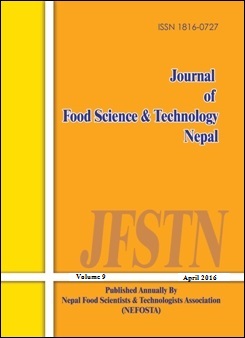Quality Assessment of Some Rice Varieties Newly Adopted in NARC
DOI:
https://doi.org/10.3126/jfstn.v9i0.12407Keywords:
amylose, cooking qualities, gelatinization-temperature, physiochemical properties, rice varietiesAbstract
Five rice varieties newly adopted in NARC were studied for their varietal differences in relation to quality characteristics such as physicochemical and cooking qualities. In physical analysis bulk density, density, thousand kernel weight and length to breadth ratio were recorded as highest in ‘Lumle-2’ (0.602gm/ml), ‘Lumle-2’ (27.789gm), ‘UPLRI-5’ (1.361gm/ml) and ‘IET-16775’ (4.710) varieties respectively. The milling and head rice recovery were recorded maximum in ‘Lumle-2’ (78.821%) and ‘UPLRI-5’ (78.282%) respectively. Protein, fat, amylose, crude-fiber and total-ash were ranged from 8.292-13.346%, 1.147-1.872%, 24.541-27.396% and 0.707-1.379% respectively. Iron, phosphorous and calcium content were estimated in the range 1.016-2.325mg/100g, 204.036-336.532mg/100g and 16.189-29.813mg/100g respectively. From organoleptic test, ‘IET-16775’ variety was scored as strongest aroma. ‘Lumle-2’, ‘Chhomrong’, ‘Machapuchhre-3’ varieties were shown as intermediate gelatinization-temperature and ‘UPLRI-5’ and ‘IET-16775’ varieties were recorded as high gelatinization-temperature. Water uptake ratio, cooking time, elongation ratio and gruel loss were found in the range 1.696-2.667, 18-25minutes, 1.252-1.428, and 2.477-6.188% respectively.
Downloads
Downloads
Published
How to Cite
Issue
Section
License
The author will be the copyright holder of this open access journal - 'Journal of Food Science and Technology Nepal (JFSTN)'.




